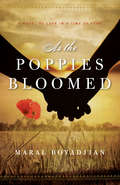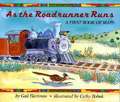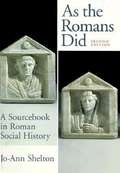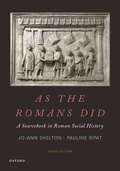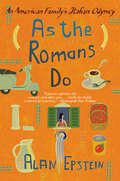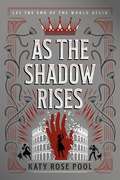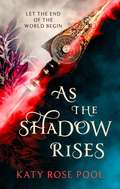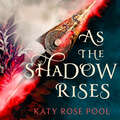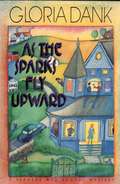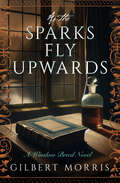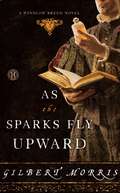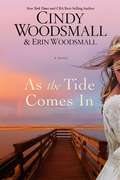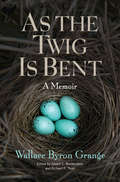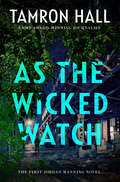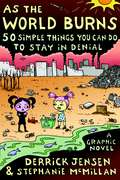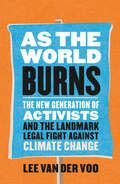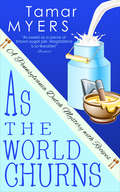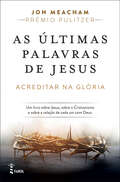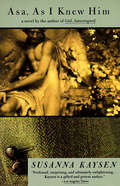- Table View
- List View
As the Poppies Bloomed: A Novel of Love in a Time of Fear
by Maral BoyadjianDouble Bronze Winner, 2015 Foreword INDIEFAB Book for the Year AwardsFinalist, Best New Fiction Category, 10th Annual National Indie Excellence AwardsFinalist, Best New Fiction Category, 2015 USA Best Book AwardsHonorable Mention, Mainstream Literary Fiction, 23rd Annual Writer's Digest Book AwardsIt is 1913 and late summer in the Ottoman Empire. The sun rises, full and golden, atop a lush, centuries-old village tucked into the highlands where the blood-red poppies bloom. Outside the village leader's home, the sound of voices carries past the grapevines to the lane where Anno, his youngest daughter, slips out unseen.She heads to a secret meeting place. She forgets that enemies surround her village. She forgets that her father meets each day with trepidation. She knows only the love she has for Daron, who waits for her as she hastens to him, once again breaking the ancient rules of courtship.Anno and Daron wish for nothing more than marriage and a better day alongside their neighbors, but neither is prepared for the dark, dangerous secret that Daron's father keeps or the upheaval that will soon envelop their village, their land, and their hearts.
As the Roadrunner Runs: A First Book of Maps
by Gail HartmanSimple maps show how different animals, including a lizard, a jackrabbit, a roadrunner, mules, and deer, travel through an area of the Southwest.
As the Romans Did: A Source book in Roman Social History
by Jo-Ann SheltonRevised to include new selections and updated bibliographical material, the second edition of this popular sourcebook offers a rich, revealing look at everyday Roman life. It provides clear, lively translations of a fascinating array of documents drawn from Latin and Greek source material--from personal letters, farming manuals, medical texts, and recipes to poetry, graffiti, and tombstone inscriptions. Each selection has been translated into readable, contemporary English. This edition includes more than 50 additional selections that introduce new topics and expand coverage of existing topics. In addition, the commentary on all the selections has been revised to reflect the recent scholarship of social and cultural historians. Extensive annotations, abundant biographical notes, maps, appendices, cross-references to related topics, and a newly-updated bibliography provide readers with the historical and cultural background material necessary to appreciate the selections. <p><p> Arranged thematically into chapters on family life, housing, education, entertainment, religion, and other important topics, the translations reveal the ambitions and aspirations not only of the upper class, but of the average Roman citizen as well. They tell of the success and failure of Rome's grandiose imperialist policies and also of the pleasures and hardships of everyday life. Wide-ranging and lively, the second edition of As the Romans Did offers the most lucid account available of Roman life in all its diversity. Ideal for courses in Ancient Roman History, Social History of Rome, Roman Civilization, and Classics, it will also appeal to readers interested in ancient history.
As the Romans Did: A Sourcebook in Roman Social History
by Jo-Ann Shelton Pauline RipatAs the Romans Did offers a rich, revealing look at everyday Roman life. It provides clear, lively translations of a fascinating array of documents drawn from Latin and Greek source material--from personal letters, farming manuals, medical texts, and recipes to poetry, graffiti, and tombstone inscriptions. Each selection has been translated into readable, contemporary English. Extensive annotations, abundant biographical notes, maps, appendices, cross-references to related topics, and a newly updated bibliography provide readers with the historical and cultural background material necessary to appreciate the selections. <p><p>Arranged thematically into chapters on family life, housing, education, entertainment, religion, and other important topics, the translations reveal the ambitions and aspirations not only of the upper class, but of the average Roman citizen as well. They tell of the success and failure of Rome's grandiose imperialist policies and also of the pleasures and hardships of everyday life. Wide-ranging and lively, the third edition of As the Romans Did offers the most lucid account available of Roman life in all its diversity.
As the Romans Do: An American Family's Italian Odyssey
by Alan EpsteinA celebration of the character and style of one of the world's most spectacular cities! This vibrant insider's view of the most mature city on earth is the perfect companion for anyone who loves anything Italian. In 1995, after a twenty-year love affair with Italy, Alan Epstein fulfilled his dream to live in Rome. In As the Romans Do, he celebrates the spirit of this stylish, dramatic, ancient city that formed the hub of a far-flung empire and introduced the Mediterranean culture to the rest of the world. He also reveals today's Roman men and women in all their appealing contradictions: their gregarious caffe culture; inborn artistic flair; passionate appreciation of good food; instinctive mistrust of technology; showy sex appeal; ingrained charm and expressiveness; surprisingly unusual attitudes toward marriage and religion; and much, much more.
As the Romans Do: Authentic And Reinvented Recipes From The Eternal City
by Eleonora GalassoRome is steeped in history and tradition, and this is reflected in the sheer vibrancy and variety of its food. In As the Romans Do, Instagram star and Roman native Eleonora Galasso will take you on a journey amongst the houses, the sanpietrini, the tiny side streets, the palazzos, the traditions, the community and the hidden gems of this never ending, always eternal city. From quick and earthy breakfasts and vivacious al fresco meals to brilliant off-the-cuff dinner parties, you will find a recipe to suit every occasion.
As the Romans Do: Authentic and reinvented recipes from the Eternal City
by Eleonora GalassoRome is steeped in history and tradition, and this is reflected in the sheer vibrancy and variety of its food. In As the Romans Do, Instagram star and Roman native Eleonora Galasso will take you on a journey amongst the houses, the sanpietrini, the tiny side streets, the palazzos, the traditions, the community and the hidden gems of this never ending, always eternal city. From quick and earthy breakfasts and vivacious al fresco meals to brilliant off-the-cuff dinner parties, you will find a recipe to suit every occasion.
As the Shadow Rises (The Age of Darkness #2)
by Katy Rose PoolSix of Crows meets Graceling with a dash of Winter is Coming in Katy Rose Pool's second installment of the action-packed and swoon-worthy Age of Darkness series--As the Shadow Rises. "As the Shadow Rises solidifies Katy Rose Pool's status as one of the best fantasy writers of the 21st century." —Popsugar The Last Prophet has been found, yet he sees destruction ahead.In this sequel to the critically-acclaimed There Will Come a Darkness, kingdoms have begun to fall to a doomsday cult, the magical Graced are being persecuted, and an ancient power threatens to break free. But with the world hurtling toward its prophesized end, Anton’s haunting vision reveals the dangerous beginnings of a plan to stop the Age of Darkness.As Jude, Keeper of the Order of the Last Light, returns home in disgrace, his quest to aid the Prophet is complicated by his growing feelings for Anton. Meanwhile, the assassin known as the Pale Hand will stop at nothing to find her undead sister before she dies for good, even if it means letting the world burn. And in Nazirah, Hassan, the kingdom-less Prince, forms a risky pact to try to regain his throne. When the forces of light and darkness collide in the City of Mercy, old wounds are reopened, new alliances are tested, and the end of the world begins. The Age of Darkness trilogy is perfect for fans of Throne of Glass, Children of Blood and Bone, and An Ember in the Ashes.* "Adventurous relic-hunting, mind-blowing twists, budding love, and terrible betrayals feature in this multiple-narrator, character-driven study of power, agency, and identity." —Kirkus Reviews, starred review Praise for There Will Come a Darkness"Reading this intricate YA fantasy, you get the feeling Katy Rose Pool’s plot is always seven steps ahead of you. You’ll want to catch up as quickly as possible." —Refinery 29
As the Shadow Rises: Book Two of The Age of Darkness (Age of Darkness #2)
by Katy Rose PoolAs the Shadow Rises is the spectacular second novel in Katy Rose Pool's Age of Darkness trilogy - a YA fantasy blockbuster packed with magic, prophecy and adventure. Katy Rose Pool 's showstopping fantasy debut There Will Come a Darkness began an epic tale of thrilling magic, ancient prophecy and five lives who could stop the approaching Age of Darkness - or unleash it.Now the adventure continues in As the Shadow Rises, as the forces of light and darkness collide - and the end of the world begins.Praise for There Will Come a Darkness'Katy Rose Pool is a writer to watch' Sebastien De Castell'A can't-miss debut from an exciting new talent' Kiersten White'Unforgettable . . . feels both utterly original and like the best of classic fantasy' Tasha Suri'Katy Rose Pool combines lovable characters, a gorgeously tangible world and an intricate puzzle-box plot to create a story that will pull you inexorably toward the explosive end' Sarah Holland
As the Shadow Rises: Book Two of The Age of Darkness (Age of Darkness)
by Katy Rose PoolAs the Shadow Rises is the spectacular second novel in Katy Rose Pool's Age of Darkness trilogy - a YA fantasy blockbuster packed with magic, prophecy and adventure. Katy Rose Pool 's showstopping fantasy debut There Will Come a Darkness began an epic tale of thrilling magic, ancient prophecy and five lives who could stop the approaching Age of Darkness - or unleash it.Now the adventure continues in As the Shadow Rises, as the forces of light and darkness collide - and the end of the world begins.Praise for There Will Come a Darkness'Katy Rose Pool is a writer to watch' Sebastien De Castell'A can't-miss debut from an exciting new talent' Kiersten White'Unforgettable . . . feels both utterly original and like the best of classic fantasy' Tasha Suri'Katy Rose Pool combines lovable characters, a gorgeously tangible world and an intricate puzzle-box plot to create a story that will pull you inexorably toward the explosive end' Sarah Holland
As the Sparks Fly Upward (Bernard and Snooky)
by Gloria DankBernard Woodruff should have known better than to expect anything but disaster from a visit to his wife's indolent but good-natured brother, Snooky. In a cabin in the Vermont woods, the irrepressible Snooky rhapsodizes about the simple pleasures of country living while preparing gourmet meals and falling in love with Sarah Tucker, a young woman whose family life is anything but simple. Bernard's depression at being away from home only deepens after he meets Sarah's assortment of relatives. There's a wealthy widowed aunt with a much younger admirer, an eccentric nature-loving spinster, a young photographer, and a blustering hunter, none of whom Bernard finds at all to his liking. But when Bernard never likes anyone, as his wife, Maya, keeps pointing out in an attempt to save Snooky's bruised feelings. Bernard is still grumbling when he stumbles on a corpse in the woods. It turns out to be the remains of the young man who had just become engaged to Sarah's rich aunt, and everyone in the family falls under suspicion. Against his will, Bernard is drawn into the murder investigation. By the end, he and Snooky join forces to track down an elusive and unlikely killer.
As the Sparks Fly Upward (The Winslow Breed Novels)
by Gilbert MorrisA young man finds his calling as a doctor in Queen Elizabeth&’s court in this Christian historical trilogy finale—a prequel to the House of Winslow series. Neither bold and rough like his brother, Adam, nor headstrong and spoiled like his sister, Adara, young Colin Winslow is a gentle soul with a special love for natural things. His interest in animals and healing brings him in contact with Meg Caradoc, a strange woman who lives in the woods, and teaches him the fine art of herbal medicine. At Oxford, an eccentric but brilliant professor, Dr. Phineas Teague, guides Colin toward a medical career. This formal training, combined with Meg&’s herbal remedies, makes Colin an insightful and successful doctor—one with the approving eye of Queen Elizabeth. Colin&’s skill quickly earns him many patients, some highly placed in the courts of both his queen and her sister, Mary Queen of Scots. Soon, this once shy young man finds himself amid court intrigue, acting covertly on the queen&’s behalf. When Colin faces his most difficult case—curing the wounds his brave brother suffered in battle—he must confront his attraction to Adam&’s wife, his unsteady faith in God, and the limits of his ability to heal.
As the Sparks Fly Upward (Winslow Breed #3)
by Gilbert MorrisThe trilogy The Winslow Breed serves as a prequel to the author's highly successful House of Winslow series (published by Bethany House). As the Sparks Fly Upward is the final book in the trilogy.Young Colin Winslow grows up feeling altogether different from the rest of his family. Not bold and rough like his charismatic brother, Adam, or headstrong and spoiled like his sister, Adara, he is a gentle soul with a special love for natural things. His interest in animals, medicine, and healing brings him in contact with a strange woman who lives in the woods, Meg Caradoc. She teaches him the fine art of using a variety of herbs to quell sickness and pain.When Colin studies at Oxford, an eccentric but brilliant professor, Dr. Phineas Teague, guides the young man to a career in medicine. The formal knowledge Professor Teague imparts, combined with knowledge of Meg's herbal remedies, make Colin an insightful and successful doctor--one with the approving eye of Queen Elizabeth on him. Colin's skill quickly earns him many patients, some highly placed in the courts of both his queen and her sister Mary Queen of Scots. This once shy and uncertain young man finds himself in the midst of court intrigue and a key player in quelling assassination plots and passing vital information to the queen's court. When Colin faces his most difficult case--curing the wounds his brave brother suffered in battle--he must confront his attraction to Adam's wife, his unsteady faith in God, and his command of medicine: will he abandon his noble role and succumb to temptation, or will he take his place as the new hero of the Breed of Winslow?
As the Sun Breaks Through (The Cliffehaven Series #15)
by Ellie Dean**************THE FIFTEENTH CLIFFEHAVEN NOVEL BY SUNDAY TIMES BESTSELLING AUTHOR ELLIE DEANCliffehaven, June 1944As the planes continue to circle over Cliffehaven, Peggy Reilly’s sister Doris must seek refuge after a V-1 blast destroys her home. Rita, Sarah and the other residents at Beach View Boarding House quickly find their peace disturbed and it’s not long before even Peggy loses her patience. But with more bad news to come, will Doris finally be forced to swallow her pride? Meanwhile Peggy’s father-in-law Ron Reilly is delighted when his sweetheart Rosie returns home. Until a heart-breaking confession suggests things may never be the same between them. With loved ones scattered far and wide across the globe, and tensions running high, the end of the war feels somehow further than ever. And yet with the long-awaited Allied invasion in sight, a glimmer of light is starting to break through…A fabulous, heart-warming Second World War novel in Ellie Dean's bestselling Cliffehaven series (previously called the Beach View Boarding House series).
As the Tide Comes In: A Novel
by Cindy Woodsmall Erin WoodsmallA New York Times best-selling author releases her first southern novel, a Steel Magnolias-meets-Sweet Home Alabama story set on St. Simons Island.When an unthinkable loss sends Tara Abbott's life spiraling out of control, she journeys from North Carolina to Georgia's St. Simons Island. Although confused and scared, she hopes to find answers about her past - her life before the years of foster care and raising her two half-brothers as a young adult. Will she find steady ground on the island, surrounded by an eccentric-but-kindhearted group of older women called The Glynn Girls and a determined firefighter? Or will the truth splinter what's left of her identity into pieces?
As the Twig Is Bent: A Memoir
by Wallace Byron GrangeWallace Byron Grange (1905–87) was an influential conservationist who worked alongside Aldo Leopold. Grange’s story vividly describes his mostly idyllic childhood watching bird life in the once grand prairies just west of Chicago. He documents his family’s journey and pioneering struggle to operate a farm on the logged cutover country in northern Wisconsin, a land that provided him with abundant opportunities to study the lives of wild creatures he loved most. Written when Grange was in his sixties, As the Twig Is Bent conveys how a leading conservationist was formed through his early relationship to nature. In beautifully composed vignettes, he details encounters both profound and minute, from the white-footed mice attracted by cookie crumbs in his boyhood clubhouse to the sounds of great horned owls echoing through the wintry woods. As he develops his own understanding of the natural world, he comes to an awareness of the dramatic and devastating role of humankind on ecosystems. Grange’s poignant observations still resonate today amid global conversations about the fate of our natural resources and climate change.
As the Wicked Watch: The First Jordan Manning Novel (Jordan Manning series #1)
by Tamron HallThe first in a thrilling new series from Emmy Award-winning TV Host and Journalist Tamron Hall, As The Wicked Watch follows a reporter as she unravels the disturbing mystery around the deaths of two Black girls; the work of a serial killer terrorizing Chicago.When crime reporter Jordan Manning leaves her hometown in Texas to take a job at a television station in Chicago, she’s one step closer to her dream: a coveted anchor chair on a national network.Jordan is smart and aggressive, with unabashed star-power, and often the only woman of color in the newsroom. Her signature? Arriving first on the scene—in impractical designer stilettos. Armed with a master’s degree in forensic science and impeccable instincts, Jordan has been able to balance her dueling motivations: breaking every big story—and giving a voice to the voiceless.From her time in Texas, she’s covered the vilest of human behaviors but nothing has prepared her for Chicago. Jordan is that rare breed of a journalist who can navigate a crime scene as well as she can a newsroom—often noticing what others tend to miss. Again and again, she is called to cover the murders of Black women, many of them sexually assaulted, most brutalized, and all of them quickly forgotten.All until Masey James—the story that Jordan just can’t shake, despite all efforts. A 15-year-old girl whose body was found in an abandoned lot, Masey has come to represent for Jordan all of the frustration and anger that her job often forces her to repress. Putting the rest of her work and her (fraying) personal life aside, Jordan does everything she can to give the story the coverage it desperately requires, and that Black children rarely receive.Jordan is convinced that there’s a serial killer on the loose and he’s hiding in plain sight.
As the Witnesses Fall Silent: 21st Century Holocaust Education in Curriculum, Policy and Practice
by Zehavit Gross E. Doyle StevickThis volume represents the most comprehensive collection ever produced of empirical research on Holocaust education around the world. It comes at a critical time, as the world observes the 70th anniversary of the liberation of Auschwitz. We are now at a turning point, as the generations that witnessed and survived the Shoah are slowly passing on. Governments are charged with ensuring that this defining event of the 20th century takes its rightful place in the schooling and the historical consciousness of their peoples. The policies and practices of Holocaust education around the world are as diverse as the countries that grapple with its history and its meaning. Educators around the globe struggle to reconcile national histories and memories with the international realities of the Holocaust and its implications for the present. These efforts take place at a time when scholarship about the Holocaust itself has made great strides. In this book, these issues are framed by some of the leading voices in the field, including Elie Wiesel and Yehuda Bauer, and then explored by many distinguished scholars who represent a wide range of expertise. Holocaust education is of such significance, so rich in meaning, so powerful in content, and so diverse in practice that the need for extensive, high-quality empirical research is critical. Th is book provides exactly that.
As the World Ages: Rethinking a Demographic Crisis
by Kavita Sivaramakrishnan SivaramakrishnanPeople are living longer, creating an unexpected boom in the elderly population. Longevity is increasing not only in wealthy countries but in developing nations as well. In response, many policy makers and scholars are preparing for a global crisis of aging. But for too long, Western experts have conceived of aging as a universal predicament—one that supposedly provokes the same welfare concerns in every context. In the twenty-first century, Kavita Sivaramakrishnan writes, we must embrace a new approach to the problem, one that prioritizes local agendas and values. As the World Ages is a history of how gerontologists, doctors, social scientists, and activists came to define the issue of global aging. Sivaramakrishnan shows that transnational organizations like the United Nations, private NGOs, and philanthropic foundations embraced programs that reflected prevailing Western ideas about development and modernization. The dominant paradigm often assumed that, because large-scale growth of an aging population happened first in the West, developing societies will experience the issues of aging in the same ways and on the same terms as their Western counterparts. But regional experts are beginning to question this one-size-fits-all model and have chosen instead to recast Western expertise in response to provincial conditions. Focusing on South Asia and Africa, Sivaramakrishnan shows how regional voices have argued for an approach that responds to local needs and concerns. The research presented in As the World Ages will help scholars, policy makers, and advocates appreciate the challenges of this recent shift in global demographics and find solutions sensitive to real life in diverse communities.
As the World Burns: 50 Simple Things You Can Do to Stay in Denial
by Derrick Jensen Stephanie McmillanTwo of America's most talented activists team up to deliver a bold and hilarious satire of modern environmental policy in this fully illustrated graphic novel. The U.S. government gives robot machines from space permission to eat the earth in exchange for bricks of gold. A one-eyed bunny rescues his friends from a corporate animal-testing laboratory. And two little girls figure out the secret to saving the world from both of its enemies (and it isn't by using energy-efficient light bulbs or biodiesel fuel). As the World Burns will inspire you to do whatever it takes to stop ecocide before it's too late. <P><P> <i>Advisory: Bookshare has learned that this book offers only partial accessibility. We have kept it in the collection because it is useful for some of our members. Benetech is actively working on projects to improve accessibility issues such as these.</i>
As the World Burns: The New Generation of Activists and the Landmark Legal Fight Against Climate Change
by Lee van der Voo&“The story of Juliana v. United States and the committed young people behind it will give you hope in the next generation.&” —Elizabeth Kolbert, author of The Sixth Extinction Do children have a right to inherit a livable planet? Is the government obliged to protect it? That&’s the question posed by Juliana v. United States, one of the most critical lawsuits of our time. Twenty-one young people from across America sued the federal government over climate change, charging that actions promoting a fossil fuel economy violate their constitutional rights to life, liberty, and property. Their trial could be the civil rights trial of the century, but it hasn&’t happened yet. As the World Burns follows the plight of the young plaintiffs, chronicling their legal battle through a year of drought and wildfire, floods and hurricanes, and the most tumultuous political season in modern history. The plaintiffs wrenchingly describe personal experiences with recurring &“thousand-year&” floods, wildfire smoke so thick they can&’t ride a bike to school, drought that threatens family farms, and disappearing coastlines that send waves lapping ominously at their doors. Along the way, journalist Lee van der Voo weaves their experience into a broader narrative of America, where politics and policy threaten the very existence of our youth and our way of life.As the World Burns is climate breakdown like you&’ve never seen it—through the eyes of the young.
As the World Churns: A Pennsylvania Dutch Mystery (An Amish Bed and Breakfast Mystery with Recipes #16)
by Tamar MyersAn Amish Bed and Breakfast Mystery with Recipes - PennDutch Mysteries #16Even though she's now married to acclaimed Manhattan doctor, Gabriel Rosen, Magdalena--still a small-town Hernia girl at heart--is delighted to be chosen as the emcee for Hernia's first annual Holstein Competition. If there's anyone who doesn't pull punches in judging cows, it's Magdalena!Plus, holding the Holstein Competition means that Magdalena's beloved bed and breakfast, the PennDutch Inn is packed with out-of-town guests, making it a real cash-cow of a weekend!But when the contest's organizer, Doc Shafor, kicks the bucket--not in a natural way!--and both Gabe and his daughter mysteriously disappear, Magdalena's perfect weekend looks more sour than curdled milk!With the help of her best friend--and the interference of her new mother-in-law--Magdalena vows to herd every clue till she nabs the daring killer, and the cows (and her family) come home!!!
As the World Goes By
by Jonny LambertThis story, just right for readers ages 3-7, celebrates finding stillness in a busy world, and appreciating the little things in life.When Buttons the dog sees a beautiful blue butterfly, he is sure everyone will want to see it, too. But among the bustle of the busy street and the chitter-chatter of the café, no one notices the insect. He tries to encourage everyone he meets to stop and admire the wonder and beauty of the butterfly, but no one does. Is there anything he can do to get everyone to focus their attention on the beautiful insect? This inspiring story celebrates finding stillness in a busy world, and appreciating the little things in life.
As Últimas Palavras de Jesus: Acreditar na Glória
by John MeachamNeste livro ímpar, Jon Meacham destaca as sete últimas frases de Jesus, conforme foram gravadas nos Evangelhos, e usa--as para pensarmos a nossa relação com Deus. Num registo mais intimista do que é habitual, o conceituado autor combina Teologia e História para realçar e descrever a herança espiritual das últimas palavras de Cristo antes da crucificação. Para Jon Meacham, bem como para os crentes em todo o mundo, os eventos da Sexta-Feira Santa e da Páscoa revelam verdades essenciais sobre a fé cristã, que aqui são partilhadas com todos. Mais do que uma nova tradução daquelas sete frases marcantes, As Últimas Palavras de Jesus é um memorável livro de sermões que deve ser lido naqueles momentos em que se procura o sentido da vida e se precisa da força das palavras do Senhor.
Asa, as I Knew Him
by Susanna KaysenDinah Sachs and Asa Thayer have had a love affair, conducted in afternoons stolen from the office of the magazine where they work. But now that the affair is over, Dinah, in an act of lingering passion, invents a narrative of Asa's youth, imagining the events that shaped the "happy, handsome man" who, in her words, "was born to stomp on my heart."Witty and sexy, funny and immediate, Asa, As I Knew Him is a a seductive dialogue between love and memory, obsession and illusion.From the Trade Paperback edition.
